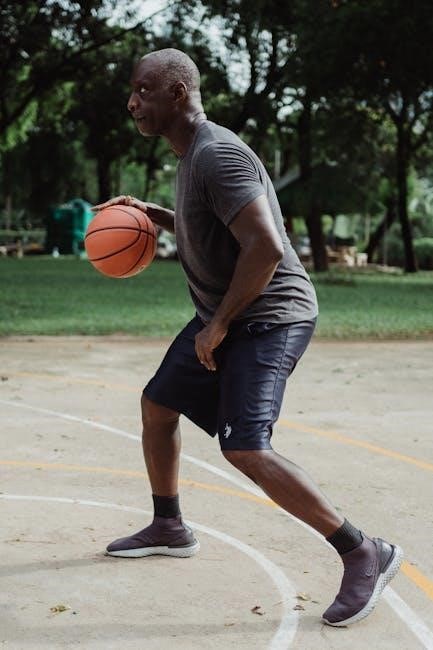Welcome to our Youth T-Shirt Size Guide! This guide helps you find the perfect fit for your child by understanding measurements, size charts, and key fit factors․
Understanding the Importance of Proper Fit
A proper fit ensures comfort, mobility, and confidence for kids․ Ill-fitting clothes can cause discomfort or restrict movement․ Measuring accurately and using size charts helps avoid sizing mistakes․ Proper fit also extends the lifespan of the garment, preventing issues like shrinking or stretching․ It’s essential to consider growth spurts and personal preferences when selecting sizes for the best comfort and style․

How to Measure for the Perfect Fit
Measure your child’s chest, height, and preferred shirt length․ Use a flexible tape measure and compare the measurements to the size chart for accuracy․
Key Measurements for Youth T-Shirts
Measure chest circumference, body length, and sleeve length for accurate sizing․ Chest is the primary measurement, while body length ensures the shirt isn’t too short or long․ Sleeve length should fit comfortably without being restrictive․ Weight and age correlations can also guide size selection․ Always compare these measurements to a well-fitting shirt for the best results․
Step-by-Step Measuring Guide
To ensure the perfect fit, follow these steps:
Use a flexible tape measure․
Measure chest circumference around the widest point․
Measure body length from the highest point of the shoulder to the desired hem․
Measure sleeve length from the center back to the wrist․
Compare these measurements to a well-fitting shirt and the size chart for accuracy․Fabric shrinkage should also be considered for long-term fit․

Understanding Youth T-Shirt Size Charts
Youth T-shirt size charts correlate body measurements with specific sizes, ensuring a proper fit․ They typically include chest, length, and sleeve measurements, aligned with age and height ranges․
These charts vary by brand but provide a standardized reference for selecting the correct size․
- Measurements are often in inches or centimeters․
- Age ranges help estimate size based on growth stages․
General Youth T-Shirt Size Chart Overview

A general youth T-shirt size chart provides standardized measurements to help determine the best fit․ Sizes typically range from XS to XL
- Chest measurements are a primary factor, ranging from 24-32 inches․
- Height and age correlations guide size selection, with age ranges like 6-8 or 12-14․
- Length and sleeve measurements are also included for accuracy․
While charts vary by brand, they generally follow similar sizing patterns to ensure consistency and ease of use․
How to Read and Interpret Size Charts
To effectively read and interpret youth T-shirt size charts, start by identifying key measurements like chest size, length, and sleeve length․ These measurements are usually provided in inches or centimeters and correspond to sizes from XS to XL․ Compare the child’s measurements to the chart, ensuring accuracy by measuring around the fullest part of the chest and desired T-shirt length from the shoulder․ Consider factors like fabric shrinkage, personal fit preferences (snug vs․ loose), and brand-specific sizing variations․ Age and weight ranges are general guides, but actual body measurements are more reliable․ Be aware that different brands may have varying standards, so always check the specific chart for each brand․ Additionally, consider regional size differences and fabric types that may affect fit․ Finally, use online fit predictors or calculators if available, and remember that fit can be subjective, allowing for flexibility in size selection․
Factors Influencing the Fit of Youth T-Shirts
Age, height, weight, and body type significantly impact fit․ Fabric type, shrinkage, and personal preference also play roles in achieving the perfect size and comfort․
Age and Height Correlations
Age and height are key factors in determining the right size for youth t-shirts․ Typically, sizes are grouped by age ranges, such as 6-8, 8-10, 10-12, and 12-14, with corresponding height ranges in inches or centimeters․ For example, a size S might fit ages 6-8 with heights around 46-50 inches, while larger sizes correspond to taller children․ This correlation helps in selecting the appropriate size, ensuring comfort and a proper fit while accounting for growth spurts and individual differences․
Weight and Body Type Considerations
Weight and body type significantly impact t-shirt fit for youth․ While age and height provide a general guide, body structure varies․ Slimmer children may prefer tighter fits, while broader builds may need roomier sizes․ Weight ranges, such as 33-42 pounds for smaller sizes, help align with body types․ Chest measurements are particularly important, as they determine how the fabric drapes․ Always consider individual proportions to ensure comfort and a flattering fit, as brands may vary in sizing standards․

Common Mistakes When Choosing a Size
Common mistakes include ignoring measurement guidelines, not considering fabric shrinking, and guessing sizes based on age alone, which can lead to poor fit and discomfort․
Ignoring Measurement Guidelines
Ignoring measurement guidelines is a common mistake that leads to poor fit and discomfort․ Accurate chest, length, and sleeve measurements are crucial for selecting the right size․ Relying on age or brand assumptions can result in shirts that are too tight or too loose․ Always compare your child’s measurements to the size chart to ensure a comfortable and proper fit․ This step is essential for avoiding returns and ensuring satisfaction․
Not Considering Fabric Shrinking
Not considering fabric shrinking is a common oversight when choosing youth T-shirt sizes․ Many fabrics, especially cotton, shrink after washing, which can make a well-fitting shirt too small․ Always check the care label for shrinkage potential and consider this when selecting sizes․ Proper fit after washing is crucial for comfort and durability․ Ignoring this factor can lead to disappointment and the need for exchanges or returns․

Differences in Sizing Across Brands
Youth T-shirt sizes vary significantly across brands due to differing measurements and fit preferences․ Always check the specific brand’s size chart for accurate sizing․
Brand-Specific Size Variations

Brands often have unique sizing standards, making direct comparisons challenging․ For example, Gildan’s Youth Ultra Cotton line may differ from Nike’s youth sizes․ Some brands, like The Mountain, offer detailed charts with measurements for chest, length, and sleeve length, while others simplify sizing by age or numeric ranges․ Always refer to the specific brand’s size chart to ensure the best fit, as variations in measurements and fit preferences exist across labels․
Popular Brands’ Sizing Charts
Leading brands like Gildan, Nike, and The Mountain provide detailed youth t-shirt size charts․ Gildan’s Youth Ultra Cotton line offers unique sizing, while Nike includes measurements for chest, length, and sleeve length․ The Mountain provides specific charts with age, height, and body measurements․ Always refer to the brand’s official sizing guide for accurate fit, as variations exist between brands and their specific product lines․
Care Tips to Maintain Fit
Proper washing, drying, and ironing techniques help maintain the fit and quality of youth t-shirts․ Follow care labels to prevent shrinkage and preserve the garment’s shape․
Washing Instructions
For optimal care, wash youth t-shirts in cold water to prevent shrinkage․ Turn shirts inside out to protect designs․ Use mild detergent to avoid fabric irritation․ Avoid bleach and harsh chemicals․ Gently remove immediately after washing to maintain shape․ Air-dry or tumble dry on low heat to prevent shrinkage and fading․ Iron inside out on low heat if needed․ Always follow care label instructions for specific fabric types․
Drying and Ironing Guidelines
For lasting quality, air-dry youth t-shirts or tumble dry on low heat․ Remove promptly to avoid wrinkles․ Iron inside out on low heat to protect designs․ Avoid ironing graphics or logos․ Use a gentle setting to prevent fabric damage․ Always check the care label for specific instructions, especially for blended or specialty fabrics․ Proper drying and ironing ensure a crisp, long-lasting fit and appearance․

How to Choose the Right Size
Match your child’s measurements to the size chart, ensuring comfort and style․ Consider their fit preference—relaxed, slim, or standard—to make the best choice for their needs․
Comparing Measurements to Size Charts
To ensure the best fit, compare your child’s measurements to the size chart․ Measure chest, waist, and length accurately․ Align these with the chart’s corresponding sizes․ For example, if their chest is 28 inches, they likely fall into a medium or large, depending on the brand․ Check the fit of their current favorite shirt for reference․ Remember, slight variations exist between brands, so always double-check the specific size chart provided for accuracy and comfort․
Considering Personal Fit Preferences
Personal fit preferences play a crucial role in selecting the right size․ Some children prefer a snug, slim fit, while others like a relaxed, loose style․ Consider their body type and comfort level․ If they tend to grow quickly, you might opt for a slightly larger size․ Always check the size chart and fabric type to ensure the chosen size aligns with their comfort and style preferences for the best fit․

Using the Size Chart Effectively

Match your child’s measurements to the size chart accurately․ Compare chest, height, and body length to ensure the best fit․ This step guarantees comfort and style․
Matching Measurements to Sizes
To ensure the best fit, align your child’s chest, height, and body length with the size chart․ For example, a chest measurement of 24-25 inches corresponds to a Small size, while 28-30 inches fits a Large․ Use a tape measure to get accurate numbers, ensuring the shirt isn’t too tight or loose․ Consider the fabric type, as some materials may shrink slightly․ Proper alignment guarantees comfort and style for your child․
Ensuring Accuracy in Size Selection
Achieve precise fit by measuring your child’s chest, height, and body length, then compare these to the size chart․ Double-check the measurements against a well-fitting shirt they already own․ Consider growth spurts and fabric shrinkage․ Use a flexible tape measure and ensure the child stands straight during measurement․ Accurate sizing prevents returns and ensures comfort, making the process efficient and stress-free for both parents and kids alike․
With this guide, you’re equipped to find the perfect fit for your child․ Proper sizing ensures comfort and confidence, making every outfit a success․ Happy shopping!
Final Tips for a Perfect Fit
Always measure your child’s chest, height, and compare with size charts․ Consider fabric type and shrinkage․ Refer to brand-specific guides for accuracy․ Check reviews for sizing insights․ Ensure comfort by choosing a slightly roomy fit․ Double-check measurements before ordering․ For consistent fit, use the same method each time․ Happy shopping for the perfect tee!
Encouragement to Use the Guide
Using our Youth T-Shirt Size Guide ensures your child’s comfort and confidence․ Proper fit enhances their style and satisfaction․ By following the guide, you’ll avoid costly returns and find the perfect size every time․ Happy shopping and enjoy seeing your child in their new favorite tee!
